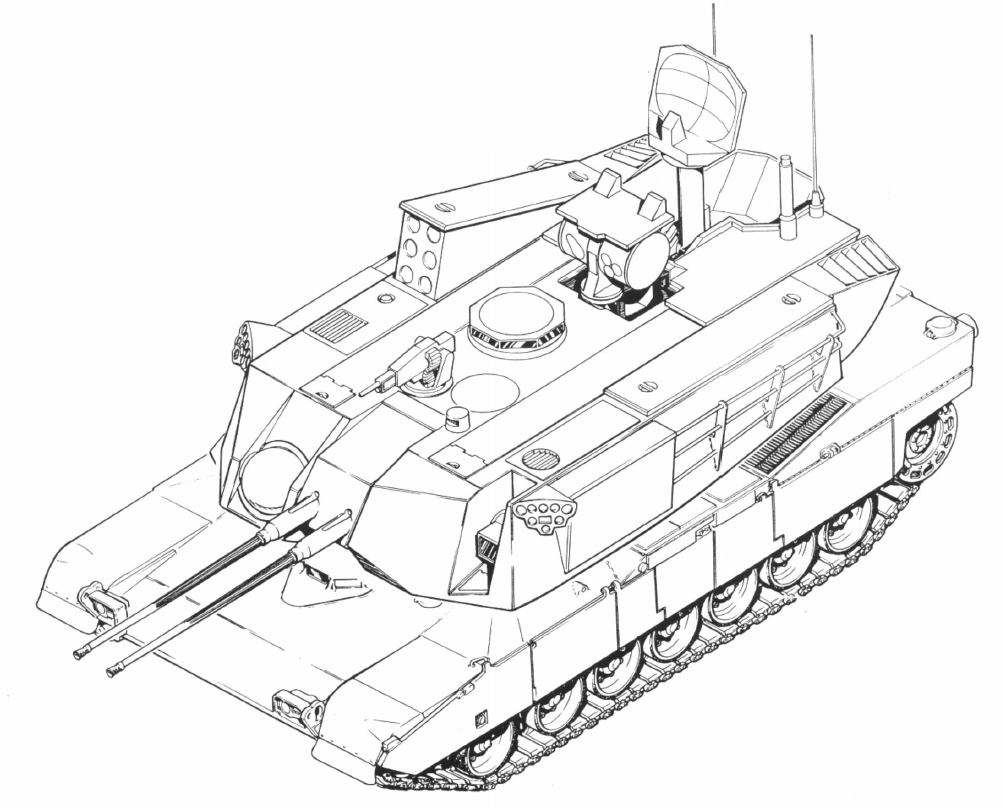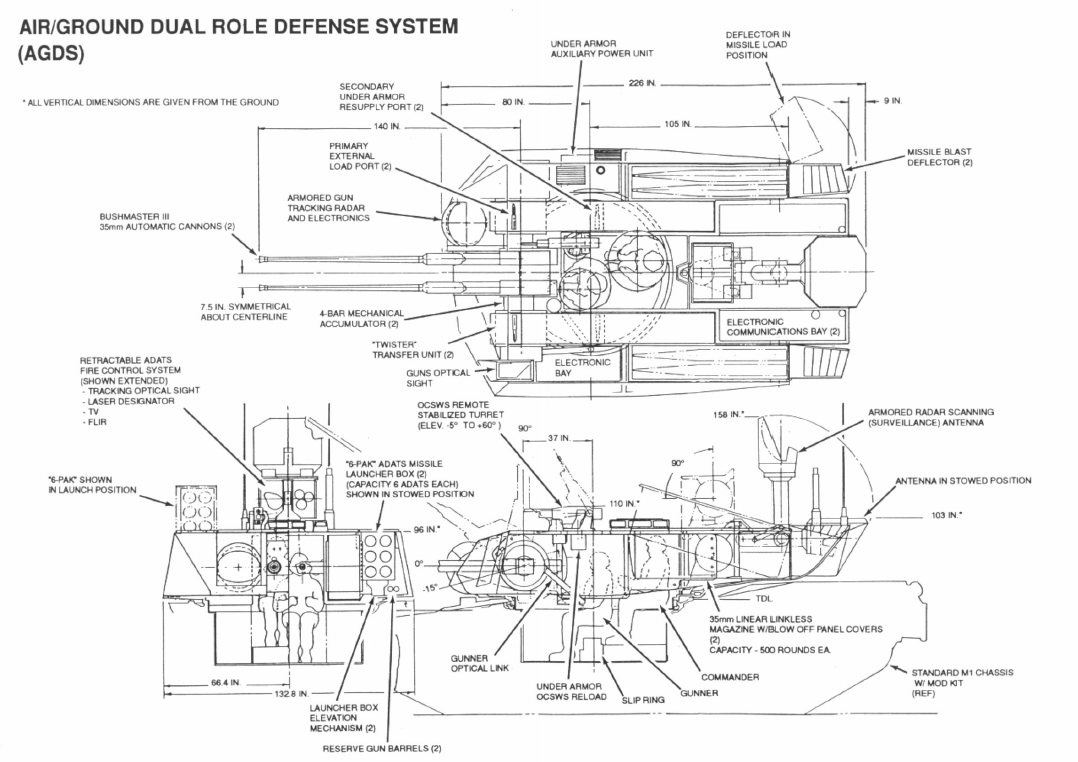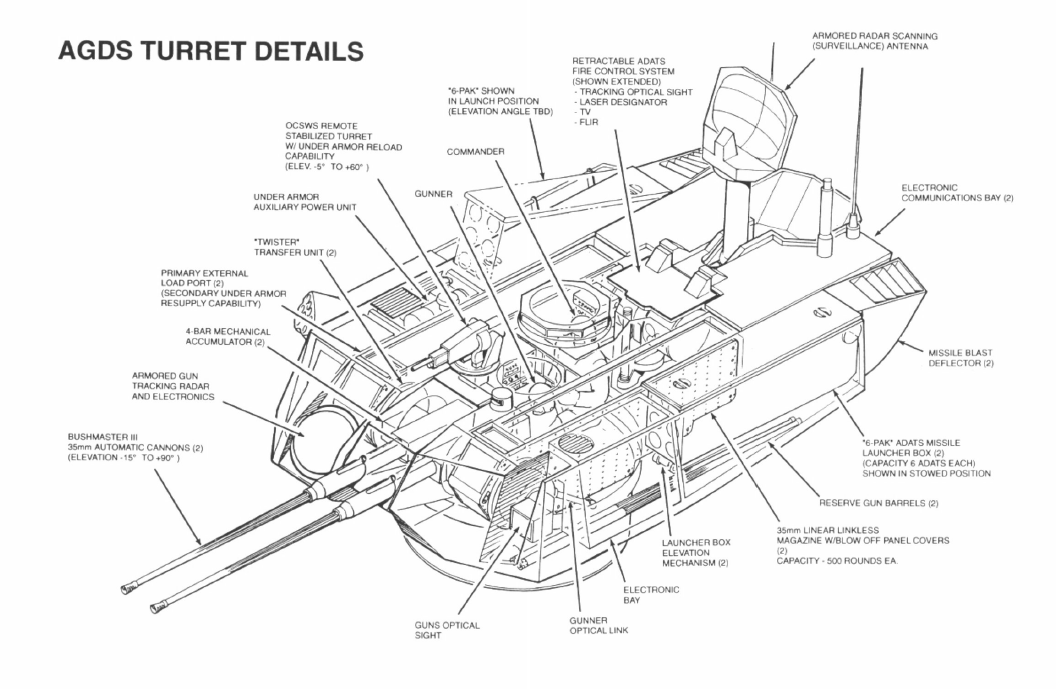Check this out. The source of this is the American Journal of Military Ordnance, more than 2 decades old. It’s amazing what you can find in the old sources. Very special thanks to Captain Nemo for this one.
This is a proposed AA variant of the Abrams MBT, equipped with two 35mm Bushmaster Mk.III cannons and an ADATS missile launcher from the early 1990s. It was designated M1/AGDS (Air-Ground Defense System). Existing M1 tanks were to be converted to this mobile AA vehicle, intended to provide short-to-medium range AA support against slower airplanes and helicopters. The guns were guided by a dual-beam X-band pulse Doppler radar with the range of 25km. Each could fire approximately 250 rounds per minute of 35mm anti-air and anti-armor rounds, can engage ground targets. The vehicle was to carry two 500 round magazines for AA rounds and small 40-50 round magazines for AP rounds. Maximum gun range – approximately 3km.
The 152mm ADATS missiles are dual-purpose and weigh 51kg. They combine HEAT and HE-FRAG capabilities and maximum AA range of some 7-8km (depending on the type of target). Can be used against both air and ground targets (maximum ground range is approximately 10km).
The M1/AGDS proposal was never built.




20 decades old?? you mean 2 decades right?
Lol ye typo
“too bad” the US military never really invested in short-medium range SPAA (other than the M163 and WWII or early cold-war vehicles), would definitly be a interesting vehicle with the missiles popping-out from the turret
somehow it seems awfully similar to another SPAA on a M48 chassis also with twin 35mm, with air-burst rounds, and dopler radar, I think that program sounded similar to AGDS but can’t remember for sure
I don’t think so, this program would have been costly and not very efficient I think, think about what made the Shilka for example one of the best AAAs there is, That’s cost, mobility and high effectiveness, on the other hand this Triple A Abrams would have been expensive to make and run, Don’t forget the turbine engine, bulky and heavy, But you are correct about that US military investment in AAA, I guess they are pretty confident in their air force or something like that.
EDIT :Ok I take it back about the mobility, the M1 is already quite mobile and this would have been even lighter so a bit more mobility I think but at a high running cost due to the turbine engine, btw what’s the point of having a highly armored hull on a AAA? why not just slap this turret on another lighter hull?
Logistics. Using unified platform has tons of advantages. Or at least that was the line of thought.
logistics is of course a major advantage but I think you are all forgetting a important factor, AVAILABILITY
don’t forget that in the 90′s the US had a few M1s lying around (over 3700 built with 1st generation Chobham armour and L7 gun), in the mid 80′s they had started the M1A1 production and as you would expect they were not yet allowed to sell the british secret even to their allies and that meant a bunch of M1s being replaced with the more powerfull M1A1s and stored as reserve
like with the Leo and Gepard making the older M1s into short-medium range SPAAs would be more cost-effective than mantaining M1s on reserve, although only some since they were probably used for training and by the National Guard
“I guess they are pretty confident in their air force or something like that” not exactly, I believe they feel confident in the integrated defence
US potential enemies have to cross the sea to attack them, this means that from either side they have to avoid being shot down by the US Navy, both by sea-air missiles and carrier-born fighters, but most of all they must believe that if they can detect the enemy early enough they can defend themselves
for that you can’t forget that the Patriot System is quick and easy to deploy which would act as the second line of defense, US aircraft would by then, idealy, climb above the incoming threat and would sweep the remaining aircraft
to that you have to add that if attacked from the east coast part of the enemy would end up cornered by the US defenses and the NATO reinforcements, both aviation and navies
if their enemies don’t preentively strike the many other NATO powers they would end up with Eurofighters and Grippens on their *ss, not forgetting the F-16 that to this day still dominates everything it goes against in dogfight training, including the F-22 and F-35 with almost 100% victory rate, specially vs F-22 with thrust-vectoring
yeah, I don’t believe they have absolute confidence in their supposed superiority but instead trust in the defense plan they have been putting in place for a few decades